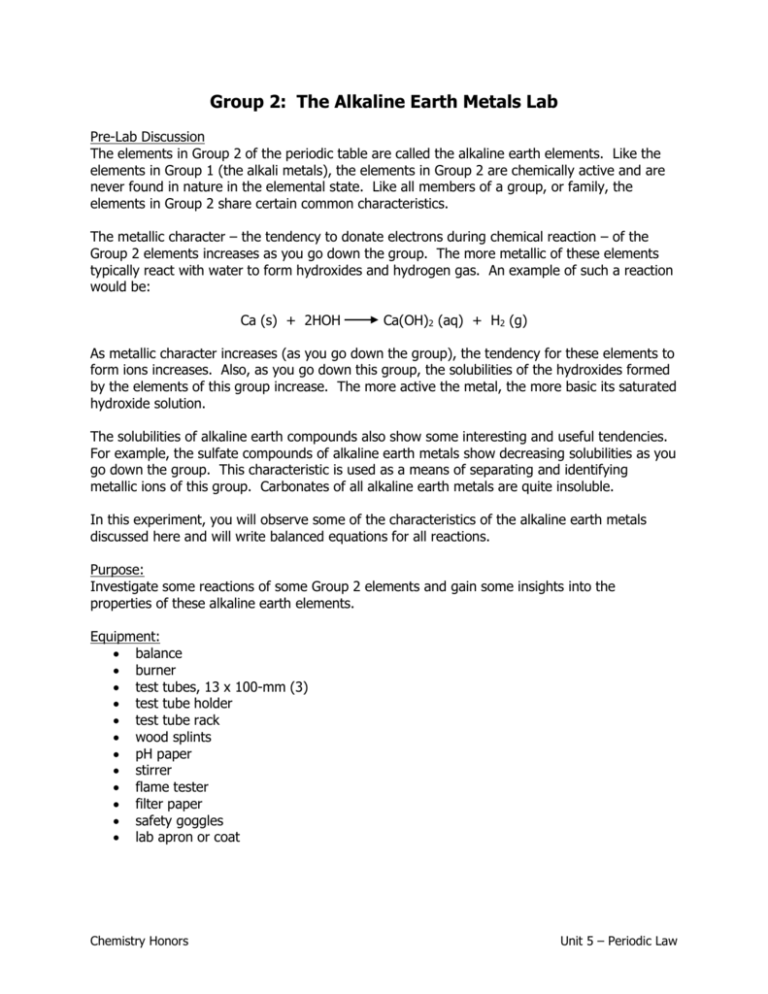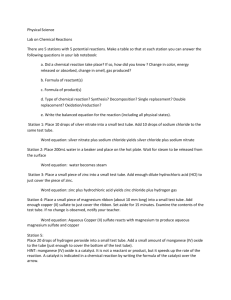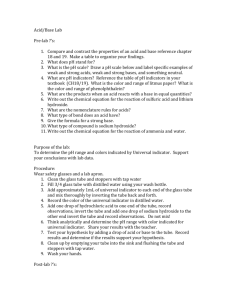Group 2: The Alkaline Earth Metals Lab
advertisement

Group 2: The Alkaline Earth Metals Lab Pre-Lab Discussion The elements in Group 2 of the periodic table are called the alkaline earth elements. Like the elements in Group 1 (the alkali metals), the elements in Group 2 are chemically active and are never found in nature in the elemental state. Like all members of a group, or family, the elements in Group 2 share certain common characteristics. The metallic character – the tendency to donate electrons during chemical reaction – of the Group 2 elements increases as you go down the group. The more metallic of these elements typically react with water to form hydroxides and hydrogen gas. An example of such a reaction would be: Ca (s) + 2HOH Ca(OH)2 (aq) + H2 (g) As metallic character increases (as you go down the group), the tendency for these elements to form ions increases. Also, as you go down this group, the solubilities of the hydroxides formed by the elements of this group increase. The more active the metal, the more basic its saturated hydroxide solution. The solubilities of alkaline earth compounds also show some interesting and useful tendencies. For example, the sulfate compounds of alkaline earth metals show decreasing solubilities as you go down the group. This characteristic is used as a means of separating and identifying metallic ions of this group. Carbonates of all alkaline earth metals are quite insoluble. In this experiment, you will observe some of the characteristics of the alkaline earth metals discussed here and will write balanced equations for all reactions. Purpose: Investigate some reactions of some Group 2 elements and gain some insights into the properties of these alkaline earth elements. Equipment: balance burner test tubes, 13 x 100-mm (3) test tube holder test tube rack wood splints pH paper stirrer flame tester filter paper safety goggles lab apron or coat Chemistry Honors Unit 5 – Periodic Law Materials: calcium turnings (Ca) magnesium ribbon (Mg) magnesium sulfate crystals (MgSO4) calcium sulfate crystals (CaSO4) barium sulfate crystals (BaSO4) distilled water phenolphthalein solution saturated solutions of: calcium hydroxide (Ca(OH)2) magnesium hydroxide (Mg(OH)2) barium hydroxide (Ba(OH)2) 0.1 M solutions of: sodium carbonate (Na2CO3) magnesium chloride (MgCl2) calcium chloride (CaCl2) barium chloride (BaCl2) Safety Handle all chemicals with care; avoid spills and contact with your skin. Heat chemicals exactly as instructed. When heating a substance in a test tube, point the tube away from yourself and others. Tie back long hair and secure loose clothing when working with an open flame. Always were safety goggles and a lab coat or apron when working in the lab. Procedure Record all observations and results in the “Observations and Data” section. Part A 1. Pour about 5 mL of distilled water into a clean, dry test tube and place the tube in the test tube rack. Add a calcium turning to the water in the tube. To collect the gas being released, invert a clean, dry test tube over the reactant tube, holding the inverted tube with a test tube holder. (see figure below) Chemistry Honors Unit 5 – Periodic Law 2. Test for hydrogen gas by inserting a burning wood splint into the upper part of the inverted tube. (see figure below) 3. Add a few drops of phenolphthalein solution to the reactant tube. After making your observations, discard the contents of the tube and clean and dry the tube. If colorless phenolphthalein turns red, this indicates a basic solution has hydroxide ions (OH-) present. Repeat step 1, using a 10-cm piece of magnesium ribbon in place of the calcium. If no visible reaction occurs, heat the water to boiling, using a test tube holder to hold the tube over the burner flame. CAUTION: Point the tube away from yourself and others while 4. 5. 6. heating. Once the water is boiling, stand the tube in a test tube rack and, using a test tube holder, invert a collecting tube over the reactant tube. After a few seconds, test for hydrogen gas. Turn off the burner and add a few drops of phenolphthalein to the reactant tube. Record your observations. Discard the contents of the tube, and clean and dry the tube. Part B 7. Obtain a dropper of saturated solutions of calcium hydroxide, magnesium hydroxide, and barium hydroxide. Test each solution with pH paper by dropping a few drops on the pH paper. Record the pH of each solution. pH 0 – 6 = acid pH 7 = neutral pH 8 – 14 = base Part C 8. Using a spatula, measure out approximately 1 M & M sized sample of magnesium sulfate. Place it in a clean, dry test tube. 9. Repeat step 8 for calcium sulfate and barium sulfate. (note; the same is most important) 10. Add 5 mL of distilled water to each tube. Using a glass stirring rod, stir each mixture thoroughly, getting as much of each solid to dissolve as possible. Record your observations of the relative solubilities of each of these compounds. Chemistry Honors Unit 5 – Periodic Law Part D 11. Stand 3 clean, almost dry test tubes in the test tube rack. Using the 0.1 M solutions, add about 5 mL of the MgCl2 solution to one tube, 5 mL of the CaCl2 solution to a second tube, and 5 mL of BaCl2 to the third tube. 12. To each of the solutions in the test tubes, add about 1 mL (2o drops) of the Na2CO3 solution. Record your observations. Observations and Data Part A Ca + HOH: Result of test for H2 gas Result of adding phenolphthalein Mg + HOH: Result of test for H2 gas (before heating) Result of test for H2 gas (after heating) Result of adding phenolphthalein Part B pH readings: Mg(OH)2 Ca(OH)2 Ba(OH)2 Part C Apparent solubility: MgSO4 CaSO4 BaSO4 Part D Observations: Chemistry Honors Unit 5 – Periodic Law Conclusions and Questions 1. Describe the reactivity of the metals in Group 2 in terms of their location in the group. 2. How does the reactivity of an alkaline earth metal compare with that of an alkali metal (Group 1) in the same period? Explain your answer. 3. What oxidation (charge) states can the alkaline earth metals exhibit? 4. Why does the metallic character of the alkaline earth metals increase as you go down the group? Explain your answer. Conclusion Chemistry Honors Unit 5 – Periodic Law






